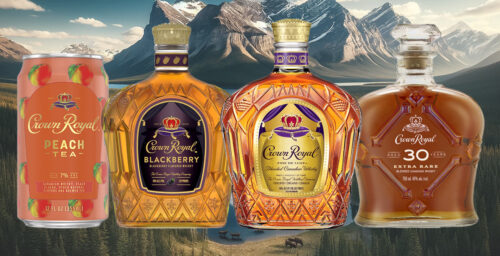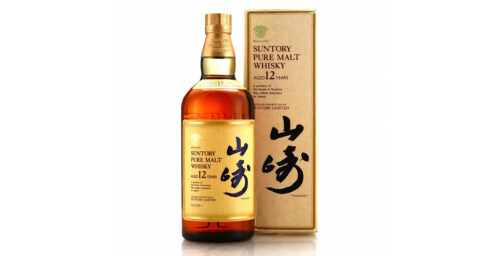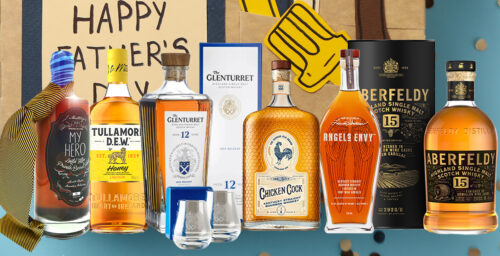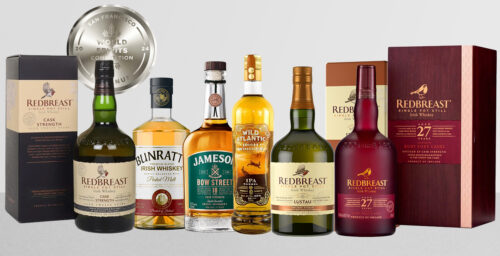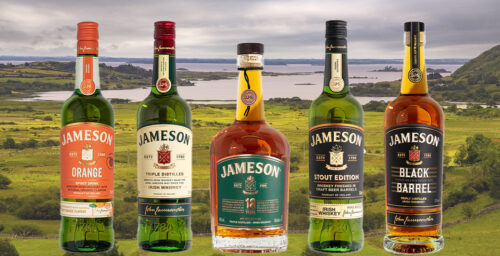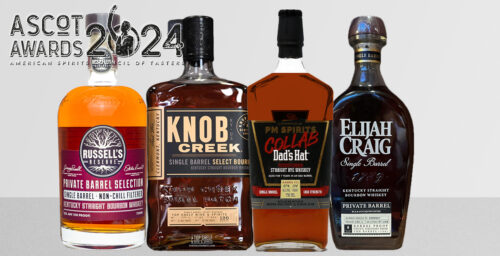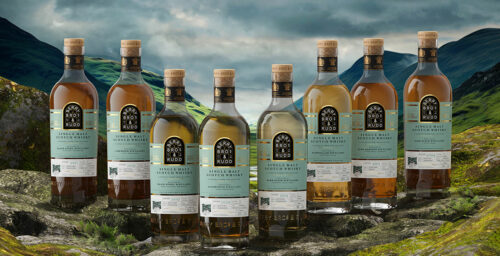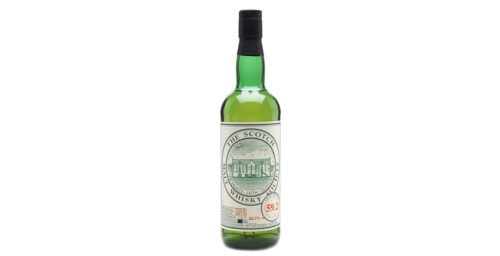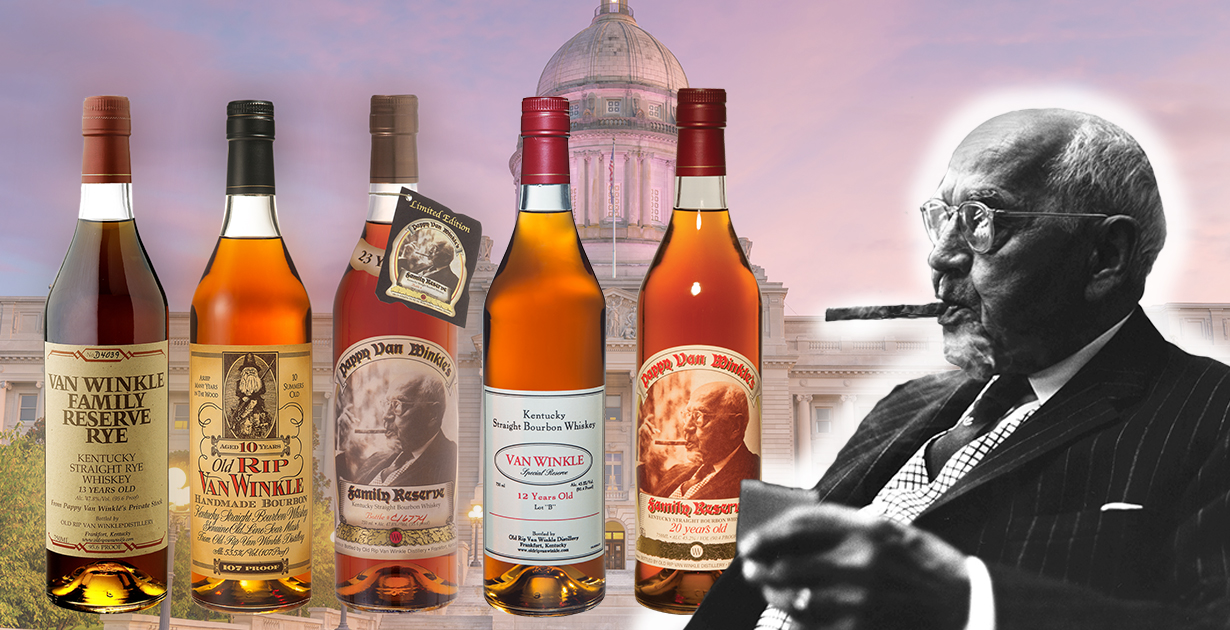
Pappy Van Winkle, now produced at the Buffalo Trace Distillery, is undoubtedly one of the most sought-after collectible bourbons in the world, renowned for both its quality and scarcity. The coveted whiskey brand only debuted on the liquor market in 1994, when the Pappy Van Winkle 20 Year Old was released.
Despite this, the brand’s origins begin well before 1994, as the Van Winkle family has been involved with the bourbon industry since the late 1800s – starting with the brand’s namesake, Julian Prentice ‘Pappy’ Van Winkle. This is the fascinating story of Pappy Van Winkle’s origins, exploring the family history and bourbon industry legacy.
Beginnings: The Liquor Salesman
Julian Prentice ‘Pappy’ Van Winkle Sr. was born in Danville, Kentucky to a family of lawyers and educators in 1874. In 1893, aged 18, Pappy Van Winkle was hired by William Larue Weller as a traveling salesman for his Louisville-based company, W.L. Weller & Sons.
A liquor wholesaler, W.L. Weller & Sons contracted with distilleries, including the locally based A. Ph. Stitzel distillery of Louisville, Kentucky, to produce their whiskey brands, which the company then marketed and sold. Traveling across the states of Kentucky and Indiana by horse and buggy, Van Winkle sold the company’s whiskey brands, including W.L. Weller and Old Fitzgerald, directly to taverns, saloons, and retailers.
After William Larue Weller retired in 1986, Van Winkle and fellow salesman, Alex T. Farnsley, partnered to purchase a controlling interest in W.L. Weller & Sons in 1903. In 1910, Van Winkle and Farnsley also acquired the controlling share in the A. Ph. Stitzel distillery, the main supplier of whiskey for Weller’s brands.
The distillery purchase ensured whiskey supplies for the creation of new Weller brands, including Old Rip Van Winkle introduced in 1919, and named after the 1819 short story written by Washington Irving.
Surviving Prohibition

On the 17th of January 1920, the 18th Amendment to the United States Constitution, widely known as American Prohibition, passed into US Federal law, prohibiting the manufacture and sale of ‘intoxicating beverages’ in the United States. The A. Ph. Stitzel distillery was one of only six distilleries in the United States that was permitted to continue operating during Prohibition, due to a license to produce medicinal whiskey.
While the A. Ph. Stitzel distillery and W.L. Weller & Sons continued to operate independently, Van Winkle was able to ensure the survival of both businesses through Prohibition, by using Weller’s distribution network to sell whiskey to pharmacies for ‘medicinal prescription’. When Prohibition ended in 1933, Van Winkle and Farnsley partnered with Arthur Stitzel to merge the companies – founding Stitzel-Weller.
The Stitzel-Weller Distillery
In May 1935, the company’s new Stitzel-Weller distillery opened in Shively, Kentucky, on the day of the Kentucky Derby. Pappy Van Winkle, aged 61, was appointed company president, and would heavily influence distillery operations and production. As a distiller, Van Winkle desired to bottle only the finest quality whiskey, declaring “We make fine bourbon. At a profit if we can, at a loss if we must, but always fine bourbon” – a quote still famously displayed on the gates of the Stitzel-Weller distillery.
The Stitzel-Weller distillery was unique as it only produced wheated bourbon whiskey, using the Stitzel family’s traditional mash recipe. Legally, all bourbon must be made from at least 51% corn, and also typically uses between 5-10% malted barley.
Often, the rest of the mash bill uses rye, but the Stitzel-Weller distillery instead used wheat which is a softer flavoring grain, producing a sweeter, smoother, and more accessible bourbon. The Stitzel-Weller distillery made the wheated style of bourbon commercially available, with the sale of brands including, Old Fitzgerald, Old Weller, and Rebel Yell.
Alex T. Farnsley died in 1941, followed by Arthur Stitzel passing away in 1948, which left the Stitzel-Weller distillery entirely controlled by Van Winkle. In 1965, Julian Prentice ‘Pappy’ Van Winkle Sr. passed away aged 91 – allegedly he was the oldest active distiller in the United States.
The Old Rip Van Winkle Era
From 1964, Pappy’s son, Julian Van Winkle Jr., operated the Stitzel-Weller distillery, until family shareholders forced the reluctant sale of the distillery and its brands to conglomerate, Norton-Simon in 1972.
Following the sale, Van Winkle Jr. resurrected the pre-Prohibition brand ‘Old Rip Van Winkle’ in 1972. As part of the Stitzel-Weller sale agreement, Van Winkle Jr. retained a portion of aging whiskey stock and first refusal to purchase any surplus barrels in the warehouse. Norton-Simon also agreed to produce and bottle the Old Rip Van Winkle brand on contract – releasing a 7 Year Old bourbon with two expressions, 90 proof, and 107 proof, often bottled in commemorative decanters.
Van Winkle Jr.’s son, Julian Van Winkle III joined the business in 1977, while the Old Rip Van Winkle brand increased its age statement from 7 to 10 Years Old. In 1981, Julian Van Winkle Jr. passed away, after which Norton-Simon informed Van Winkle III that although they would continue to produce bourbon on contract, they would no longer bottle the family’s brand.
Van Winkle III moved barrel storage and bottling to the Old Hoffman distillery in Lawrenceburg, Kentucky, although the distillery went bankrupt a few months later. In 1983, Van Winkle III purchased the Old Hoffman Distillery for $80,000.
The Birth of Pappy Van Winkle’s Family Reserve

By the early 1990s, Van Winkle III had acquired enough aging barrels from Stitzel-Weller to release 12 and 15 Year Old age-statement Old Rip Van Winkle bottlings. In 1992, the Stitzel-Weller distillery owner, Diageo, shut down production due to a bourbon industry downturn. Despite the market downturn, Van Winkle III gambled by releasing the first premium 20 Year Old bourbon ever bottled, featuring a photo of his grandfather, Julian Prentice ‘Pappy’ Van Winkle Sr. on the label, in 1994 – Pappy Van Winkle’s Family Reserve 20 Year.
While Van Winkle III feared no one would purchase the bourbon, ‘Pappy Van Winkle’ scored a then-unheard of 99 points at the World Spirits Championships 1998. The Pappy Van Winkle brand, and its legendary reputation, was born.

